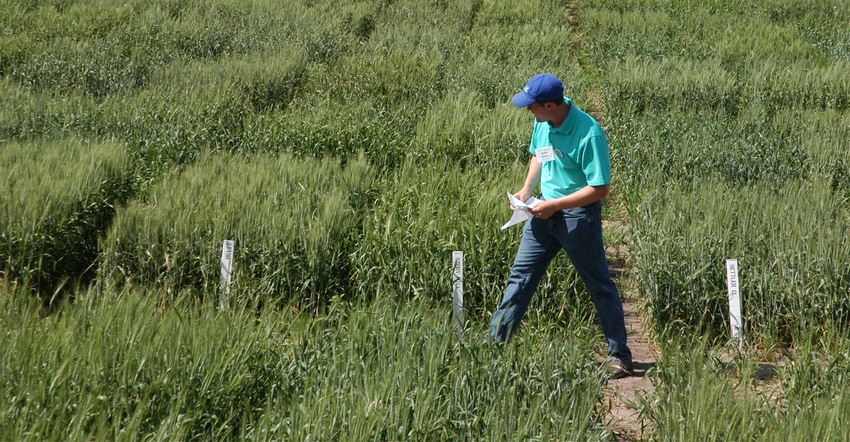
Editor’s note: This is the third of a three part series sharing how producers can implement on-farm research into their operations.
As farming continues to change, farmers are continually looking for ways to change along with it and improve along the way.
Land-grant university researchers have the same frame of mind, looking at new practices on a small-plot scale to improve farmers’ production and bottom line. Agronomist Sara Bauder says that perpetual drive for improvement, and the search for data to validate such improvement is the backbone of any research project. But data alone isn’t good enough.
“Understanding current research, it’s data, data, data, right?,” says Bauder, a South Dakota State University Extension agronomy field specialist based at the Mitchell Regional Center. “You hear the word data all the time. We’re really good at collecting it, but what do we do with it?”
Parts 1 and 2: On-farm research keeps farmer fresh and 5 tips for on-farm experiments
Data for data sake are just numbers, so Bauder says it’s important to put meaning behind those numbers, putting a measurement to a practice to visualize trends.
“If we don’t see trends, we’re just observing things in the short term,” she says. “We need to look at long-term impacts in order to know what’s affecting us positively or negatively, and what worked and what didn’t.”
Bauder says it’s not uncommon for a researcher to take another look at a current or old practice to reevaluate and “see if it’s still accurate or effective.” But the underlying theme for most research is “trying to figure out how we can do things better.” While you may find out the old way is the best way, “we need to keep looking forward and trying new things,” she says.
Follow simple process
Conducting research follows a fairly simple process:
create a hypothesis for the study
plan the study’s protocol
implement the research plan
observe and record data
perform a statistical analysis
summarize research results
report on those results
The ultimate step of any agriculture research project comes with the final decision: to repeat the research, or to implement the practice on the farm or ranch.
As to what is the most-effective and trusted research depends upon whom you ask. A majority of attendees at recent SDSU webinars put the most value in large-plot, field-scale replicated research. Bauder assumes that value is based on the impression that it more closely resembles what is happening on producers’ farms — “maybe it’s more accurate because it wasn’t babied in a small plot.”
While there is value in large-plot, field-scale research, Bauder says the small-scale, replicated approach reduces many variables, since no farm is uniform from headland to headland and fencerow to fencerow. “With large-scale outdoor field research, it’s nearly impossible to control the environment,” she says, “so we try to eliminate as many variables as we can.”
Replication, randomization
With that in mind, Bauder stresses the importance and value that a small-scale research approach can provide to both researcher and farmer alike. The keys here are replication and randomization. She shares an example of a varietal trial, where varieties are planted multiple times across the field in a random order upon each replication, or R&R. This ensures that each variety is tested across the many sources of uncontrolled variations in the field, whether it be soil type, topography, drainage, pesticide residues, compaction or insect pressure.
As researchers attempt to limit variabilities, Bauder says a small-plot replication study allows for scattered weather events to hit an entire small plot. “I’m sure you’ve probably seen in your field — if you have a decent-sized field — you can get hail on some of it, or rain falls heavier on one side than the other. Hopefully, the entire plot gets hit” by the rain or hail event.
R&R isn’t exclusive to seed variety testing, as researchers can test an almost endless number of practices, such as row spacing, fertilizer rates, herbicide treatments, insecticides treatments or various tillage practices.
Even though farmers may feel the large-scale replication over an entire field may be more applicable to their operation, Bauder stresses that smaller plots are more manageable as well as easier to observe. “It can be very difficult to walk an entire field. But when we look at a smaller plot, we can see nearly everything that’s going on,” she says.
What is going on in the small-scale research plots is, for the most part, is the same as in large field research. “They’re treated very similar,” she says. “It’s just the equipment is smaller, and it’s a little more manageable” in the small plots.
Farmer research
While university researchers will continue to operate in small-scale plot trials, in-field large plot university research is occurring as well. As more farmers look to perform research on their own fields, Bauder applauds those efforts. She says Extension educators are more than willing to assist if necessary “to make sure that those experiments are getting set up so that the data are statistically sound.”
Once producers decide on what they want researched, Bauder stresses the importance of keeping it simple, though a farmer may want answers to multiple questions. She suggests narrowing the focus to one or two things.
To illustrate the complexity that a “too-many-questions” research plot can take, Bauder uses the example of a farmer interested in how different corn hybrids react with fertilizer rates, planting populations and planting dates. “You get several things involved there, and in this situation, there’s three different treatment levels for each variable, and one replication of this trial would have 81 different treatment combinations,” she says.
In addition to Extension field specialists’ help with on-farm research, Bauder says there is potential for grant money to aid producers, and it’s best to check with Extension or specific commodity groups to see if a particular project qualifies for grant funding.
About the Author(s)
You May Also Like






